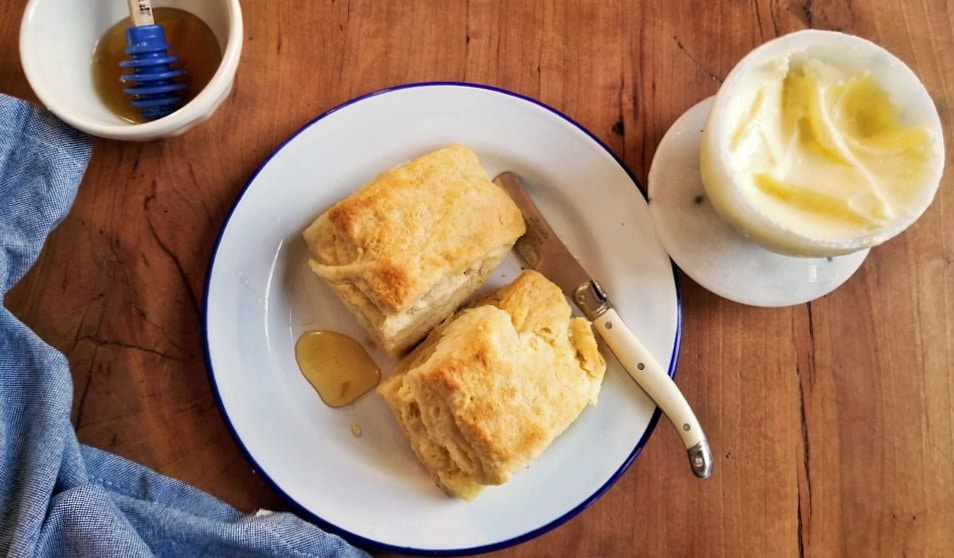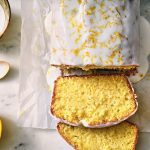Cream of Tartar Biscuits
These cream of tartar biscuits have been one of NewEngland.com’s most popular recipes for years, and to be honest, we were a bit surprised by their popularity.

Coffee By Design | Portland, Maine
Photo Credit : Katherine KeenanThese cream of tartar biscuits have been one of NewEngland.com’s most popular recipes for years, and to be honest, we were a bit surprised by their popularity. This was, after all, just a biscuit recipe, right? Sure, the use of cream of tartar—an acidic, crystalline compound that’s a byproduct of wine making—was a novelty. Maybe that had a certain old-fashioned charm. But cream of tartar is commonly found in baking powder, where it’s combined with baking soda. So why not just use baking powder and skip the extra trip to the grocery store? Why did our readers like the recipe so much?
Then we made the biscuits, and realized that our readers were on to something! And by updating the recipe a bit— replacing hard-to-find lard with unsalted butter and incorporating a folding technique that produces loftier layers—we found we had a real winner on our hands. These cream of tartar biscuits are lighter, fluffier, and crisper at the edges, and a little bit of science explains why.
You see, many biscuit doughs are made with baking powder as the leavening agent. And baking powder is typically made of 2 parts baking soda to 1 part cream of tartar. In the presence of a liquid, the acidity of the cream of tartar activates the baking soda, causing it to start bubbling away, and that, in turn, is what makes the biscuits rise.
Now, if you look at the ratios in this recipe, you’ll see that we have 3 parts cream of tartar to 1 part baking soda. So the extra acidity in the mix gives a real boost to the soda, as evidenced in the way the biscuits puff right up. The cream of tartar also adds a very subtle tang—similar to the tartness you get from using buttermilk. But since most of us don’t typically keep perishable buttermilk on hand, it’s actually easier to buy a jar of cream of tartar and make your biscuits this way, since it keeps indefinitely in your spice drawer.
So the next time you crave biscuits, give these cream of tartar biscuits a try. You’ll find that being able to control the amount of acidity and leavening in your biscuits really does produce a better product.
Yield:
8 to 10 biscuitsIngredients
2 1/4 cups all-purpose flour
3 teaspoons (1 tablespoon) cream of tartar
1 teaspoon baking soda
1/2 teaspoon table salt
7 tablespoons cold unsalted butter, cut into small cubes
3/4 cup cold milk
2 tablespoons melted salted butter for brushing
Instructions
Line a baking sheet with parchment paper and set aside. Set your oven rack to the middle position, but do not preheat it yet.
In a medium bowl, whisk together the flour, cream of tartar, baking soda, and salt. Sprinkle the butter pieces over the dry ingredients and use your fingers to blend it them together (the best technique is to rub your thumb against the tips of your fingers, as if you’re making the universal sign for “money.”) Keep going until you have a shaggy mixture with pea-sized bits and little flakes of butter. Add the milk all at once and stir with a with fork until it’s almost fully combined, then turn the dough out onto a floured surface.
Using your hands (never a rolling pin), gently press the dough out into a rough 1-inch-thick rectangle, then fold in half lengthwise, turn it 90 degrees, and gently press it out again. Repeat this process five more times, lightly sprinkling the dough with more flour as needed to keep it from sticking. On the final turn, press the dough out to a 1-inch-thick rectangle and use a pastry cutter or ruler to make the edges as straight as possible. Use a sharp knife to cut the biscuits into 8 or 10 equal pieces, depending on what size you want your biscuits to be. Transfer them to the prepared baking sheet, placing them close together but not quite touching, so that they support each other as they rise. Brush the tops with the melted butter, then transfer to the refrigerator to chill while you heat your oven to 450º.
When the oven is hot, transfer the biscuits to the oven and cook until golden brown and puffed, 9 to 12 minutes. Let cool slightly, then serve warm or at room temperature.








Thank you for this wonderful recipe! Ran out of baking powder and remembered cream of tartar. Great big white fluffy flavorful biscuits!
4 tsp of cream of tartar was a bit much, 2-3 would be just fine. You could taste the cream of tartar.
The recipe calls for 3 teaspoons not 4 of cream of tartar. This is the first thing I ever baked. My mother taught me when I was 8 years old.
Made these for my husband for strawberry shortcakes, he said these are the best he has ever eaten. Used 3 tsp cream tarter. Now I have to make them all the time.
I’m 68 and grew up in northern Maine. My grandparents were woods cooks. I remember their buiscuit recipe called fow 2 teaspoons of cream of tartar and 1 of soda. I do not remember the other ingredients. I found this and thought it might be similar. Perhaps because it was my first time cooking buscuits, but I thought these were awful. Not fluffy or flakey, and more sour than sourdough. Mine went into the trash.
First time I’ve ever made American biscuits. I had a little trouble with some of the measures, being used to weight rather than cups etc. However, I did a good job on conversions as the biscuits tasted brilliant. Very light and moreish. My son, who went to school in Maine, said they were every bit as good as the biscuits he’d eaten there! I’ll be making them again. I think I may sprinkle cheese on the top before baking next time.
These were great. Easily doubled in size and would hold up to any other flakey biscuit recipe. Next time, I plan to sprinkle flakey salt on top.
An exceptional (!) biscuit recipe!!! I’ve tried many, the difference is this biscuit is top notch in terms of flavor!! Would love to share a picture of the final product!! 😉
the very best recipe!!! bake a wonderful smelling ham, make some cream gravy and scrambled eggs on these rainy cold spring days in Maine.. enjoy all .. then go take a nap!!
Back in my biscuit baking days, when I had family, I used to put in a 500 degree oven, bake for 5 minutes, turn oven off and not open door. Remove biscuits 20 minutes later. Always perfect.
Is there a way to access the old original recipe? I’m a fan of lard and it is available here. Thank you.
I am with up Barbara nothing like Lard!!
Does any one remember Bakewell Cream, from Bangor,Maine?
Yes, I use it to make my biscuits all the time. It can be found around Thanksgiving at Hannaford’s and a few cooking stores.
I used the recipe on the cream of tartar can, but cut it down to 1 cup flour, 1 teaspoon cream of tartar, 1/4 teaspoon baking soda, 1/4 teaspoon salt, 2 tablespoons crisco shortening and 1/3 cup milk. Knead and cut out. Makes 3 biscuits. Cook at 450° for 5 minutes, turn off oven and leave for anothr 5. Every batch has been perfect.
1/2 tsp baking soda. Sorry.
One of the first things my grammy taught me to bake! <3 Nice memory of time spent with her in the kitchen! <3
I just come to say, I thought I was the only one who made square biscuits!! ????
Good morning Biscuits. Lately, I have been baking Hockey pucks for biscuits- no matter what recipe used. Think it may be the H20. But this morning, I will try the Cream of Tarter Biscuits.
I beg to differ. Buttermilk is easily found in Maine if not all over New England, Kate’s being the best because it’s made the old fashion way. And dairy farmers generally have buttermilk some with flecks of butter. I make my own baking powder with 2 parts Bakewell Cream to 1 part baking soda
BISCUITS — the cream of tarter and soda recipe-type are the BEST (personally, I like my biscuits to be ROUND. How about you? )
these are the best biscuits I ever made ,, they rose to 21/2 Inches ,, with layers I am in my 80s and bake a lot
I am so glad I found this website. I tried 2x to make biscuit an gave up years ago. Now that we are in this PANDEMIC , i have enjoy cooking real food for mom and I. These comments about Biscuit give me hope. I understand that process better now very happy to try again. Thank you all.
Can you use buttermilk with this recipe
sounds great, I am looking forward to making them. Thank you
These are so good. Very tender and flaky. I had a good recipe already but will replace it with this one. It’s a lot easier! Lol. Only thing I did different was to add a tablespoon of sugar. I like a hint of sweetness in a biscuit.